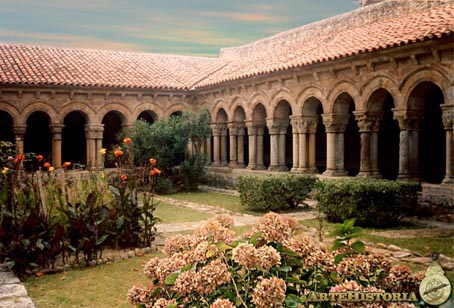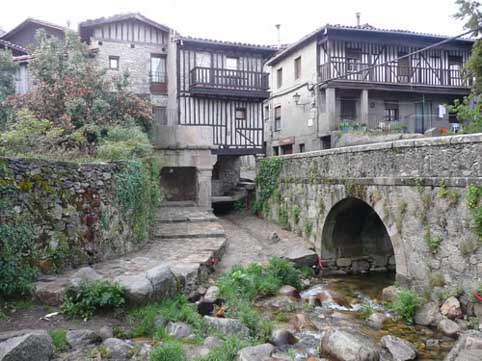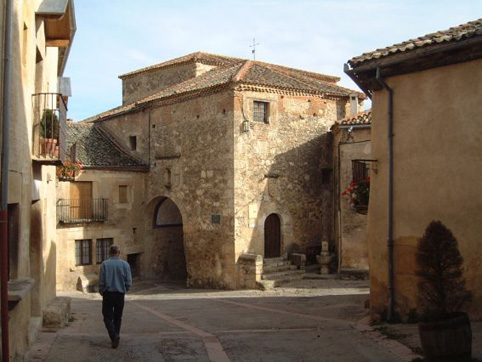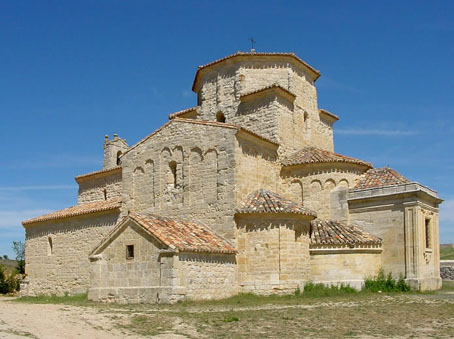I have found an article, in which a list of some of the most beautiful villages of Spain was given. Some of them may already be known by you and others will be known by you, for the first time. This classification is made by ABCViajar.
The first village is Santillana del Mar. This is a nice village, situated in the western coast of Cantabria, in the North of Spain.
Close to Santillana, you can visit the famous “Cave of Altamira”. Therefore, many tourists visit this village, every year.

A general view of Santillana del Mar, Cantabria, North of Spain

Santillana del Mar

Main square in Santillana del Mar

The Collegiate church in Santillana

The Collegiate of Santillana inside

A nice street in Santillana
Another nice village is Castrillo de los Polvazares, in León, in the North western Spain.There you can eat a famous dish, named “Cocido maragato”. The “Cocido Maragato” (“Stew Maragato”) is a stew consisting basically in a soup, collard greens, potatoes, chickpeas and seven varieties of meat. It is characterized mainly because it is served "backwards", ie, first cooked meats, then vegetables and, finally, soup. Where do you can eat this stew and another dishes; well, I recommend you the Hostería Casa Coscolo, on the street El Rincón, 1, (Plaza de la Iglesia), Castrillo de los Polvazares, Astorga, León. Telephone number: 987 691 984. Mobile: 619 280 540.
Castrillo de los Polvazares is situated beside the Santiago´s road. Its name comes from the Maragatería region.

Castrillo de los Polvazares

Castrillo

Hosteria Casa Cascolo
Now, I am going to tell you about the village La Alberca, in the Sierra de Francia, Castilla-León, North western Spain.
Almost all the buildings, in La Alberca, were made between the seventeenth and eighteenth centuries.

The nain square with a cross in La Alberca

House country river La Llana, La Alberca
Another important village is Albarracín. It is situated in the province of Teruel and the region of Aragón, in northeastern Spain. It is declared National Monument, since 1961. And it is waiting for being declared World Heritage Site, by UNESCO, thanks to the beauty and important of its historic patrimony. This is one of the greatest villages, cause of historic reasons, in the province of Teruel.

Albarracín with its walls

Albarracin

Cathedral of Albarracin
Now, I am going to talk to you a little bit about the village Morella, in the north of the province of Castellón (east of Spain, higher than Valencia).
Morella climate is high mountain Mediterranean (fresh in summer and a cold winter).
Morella is bordering on Teruel. The N-232 is the communication hub of Morella with Zaragoza and Logroño. Also, this road connects Morella with the Valencian coastal tourist destinations, with the Mediterranean Motorway (A-7) and the N-340. From Castellón, you can also access the city, by the N-238, which links later with the N-232, towards Morella.

Morella, Castellon

Castillo de Morella

Morella from the Castle

The main square in Morella

A Medieval street of Morella
The next village, that I want to show you, is Guadalupe, in the province of Caceres, in the Autonomous Community of Extremadura (northwest of Andalucia).
According to tradition, a shepherd found a statue of the Virgin Mary, on the Guadalupe River, in the late thirteenth or early fourteenth century. Near the place, where he found the image, a chapel, around which emerged the current settlement with the name of Puebla de Santa María de Guadalupe, was built. Since the construction of the first sanctuary, Guadalupe became the most important pilgrimage centre of the Iberian Peninsula, after Santiago de Compostela, a condition that continues, today, through the pilgrimage arrives, in Spain, on the roads of Guadalupe. This is due to the fact that, if Santiago is the patron of Spain, the Virgin of Guadalupe is the patron saint of all Spanish-speaking lands and holds the title of Queen of Spain, by the Catholic tradition. The current Monastery of Santa María de Guadalupe is considered one of the greatest symbols of Extremadura and the Virgin of Guadalupe is patroness of this region. Anyway, there are another important monuments.

Guadalupe, Caceres

The Monastery of Guadalupe

The Main square of Guadalupe

A street of Guadalupe
Going from the south to the north western Spain, we arrive to the village Aínsa, in the province of Huesca and the region of Sobrarbe, Autonomous Community of Aragón.
Aínsa is situated in the Pyrenee of Huesca. And, beside Boltaña, it is the historical head of the region of Sobrarbe, of the old County of Sobrarbe.
The original nucleus, that is located on a promontory overlooking the confluence of the Cinca and Ara rivers, consists of two almost parallel streets, the Mayor street and Santa Cruz street; the Plaza Mayor, which is situated below the castle, in an esplanade, near the Covered Cross temple, where legend places the miracle of the appearance of the cross, on an oak fire, which gave victory to the Christian troops, under the King García Jiménez.
With clear medieval layout, the historic town of Ainsa is declared a “Historic-Artistic Site”, in 1965.
 a 4 cm.jpg)
Plaza Mayor (Main Square) of Aínsa

The Church of Santa María, in Aínsa

Main street of Ainsa
Now, I should like to show you another nice city, in the north of Spain: Frias. It is in the north of the province of Burgos, in the region of Las Merindades, in the Autonomous Community of Castilla-Leon (North-west of Spain).
On the hill of La Muela, and close to the wide and mighty river Ebro, a strategic enclave of passage of that river was formed, since Roman times and especially in medieval times, linking the Cantabrian coast and the plateau, leading remarkable prosperity to Frias and its monuments.

Frias, Burgos

The River Ebro close to Frias
It maintains a medieval urban structure, that crowns the castle of the Velasco and the church of San Vicente. Buildings maintain an structural system, in which they join firmly together. The upstairs suntrap employs tuff and a lattice of wood.

The Castle of Frias

The church of San Vicente, Frias, Burgos
A curiosity: Frias is the smallest city in Spain.

A typical street in Frias
I want you to pay attention to another nice village: Pedraza de la Sierra. It is situated in the province of Segovia, 37 kms to the northeast from the capital. it is a walled medieval town. Its careful rehabilitation motivated its declaration as Historical Set, in 1951.
Its name seems to derive from the Roman Pretoria, although the first historical data back to Mr. Fernando Gomez de Albornoz, greater commander of Montalban, who was appointed, by the King Henry II of Castile, Lord of Pedraza. Later it passed into the hands of the Herrera family and the late fifteenth century, it passed to the constables of Castile, by marriage of Mrs. Blanca Herrera and Mr. Bernardino Fernandez de Velasco. It was remained, in these hands, until the manors were abolished, in the nineteenth century. The constables settled there, being the place waypoint for great personalities such as artists, nobles and monarchs. In the sixteenth and seventeenth century, the heyday of the village took place, and it is when the most houses and palaces date. This prosperity was due, among other things, to export to northern Europe, of the wool of their flocks of Merino sheep and their excellent fabrics, able to compete with the best, that were made in Flanders.

Pedraza de la Sierra, Segovia

A view of Pedraza
The door of the villa is the only access to Pedraza, and therefore is used as input and the only way out of the town. Its origins date back to the eleventh century, and was rebuilt in the sixteenth century as the Lord of Pedraza, Iñigo Fernandez de Velasco, whose coat dominates the entrance. The gates are made of black poplar and, during several centuries, they were closed overnight, preventing the entry or exit of any person, except emergency; in that case, the jailer was responsible for opening the door.
 a 16 cm.jpg)
The door of the villa of Pedraza

Open gates to exit from Pedraza

A nice street of Pedraza

Main Square of Pedraza and the tower of the church

Another street of Pedraza
The town is decorated with thousands of candles at the beginning of July (first and second Saturday of that month). Public lights are switched off and many windows are closed, if you want to catch some light, in order to highlight the street lighting, windows, squares, gardens and patios. Simply placing lit candles takes several hours in the evening.
 a 16 cm.jpg)
"La noche de las velas" (the night of candles), at sunset, in Pedraza

La noche de las velas in Pedraza
And, finally, another nice village is Urueña, in the province of Valladolid, in the Autonomous Community of Castilla y Leon, in the northwest of Madrid.

Urueña with its wall
Urueña has one of the best preserved urban centres of the province of Valladolid, offering its visitors the appearance of a small town medieval. For this reason, it was been declared a Historic-Artistic Site, in 1975. It retains much of the wall, with two of its doors.

Villa of Urueña

The wall of Urueña
It also preserves some paintings of the castle.

The Castle of Urueña
And it is very important the Hermitage of Nuestra Señora de la Anunciada. The invocation of the Virgin Annunciation is a long tradition, in this town, celebrating its festivitie,s on March 25, and the pilgrimage, on September 8.

Hermitage Nuestra Señora de la Anunciada, Urueña, built in the century XI
There are also some large houses of stone.

Large houses of stone in Urueña
The church of Santa Maria de Azogue is the only church, in Urueña, and it is within the walls, beside the “Door of the Azogue” and built among the centuries XVI and XVIII. It has three styles: Gothic, Renaissance and Baroque.

Church Santa Maria of Azogue, Urueña
Well, I hope that you have liked this post and, above all, I should be happy if you could come to Spain, in order to visit any of these places. If it is so, please comment it here, in Eye On Spain.
Thanks for reading my blog and, until my next post, kind regards,
Luis.
Sponsored by Costaluz Lawyers.
Please click below:
